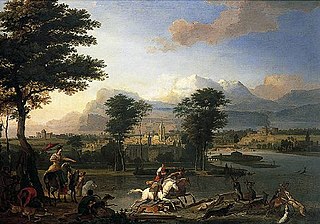Top Qs
Timeline
Chat
Perspective
Abraham Hondius
Dutch Golden Age painter From Wikipedia, the free encyclopedia
Remove ads
Abraham Danielsz. Hondius (about 1631 – 17 September 1691) was a Dutch Golden Age painter known for his depictions of animals.
This article relies largely or entirely on a single source. (June 2025) |

Career
Hondius was born in Rotterdam. He was the son of a city stonemason, Daniel Abramsz de Hondt. Hondius trained under Pieter de Bloot (1601–1658) and Cornelis Saftleven.[1] He lived in Rotterdam until he moved to Amsterdam in 1659. He migrated to London in 1666, where he spent the rest of his life. Throughout his career, Hondius combined several stylistic influences and struggled to develop a style of his own. However, he specialized in animal pieces: more than two-thirds of his paintings, etchings and drawings are hunting scenes, animals fighting and animal studies. He also painted landscapes, genre and religious scenes. He also painted views of London such as The Frozen Thames and London Bridge. His last known work is Ape and Cat Fighting over Dead Poultry, dated 1690.[citation needed]
Remove ads
Gallery
- The Proclamation to the Shepherds, 1663, Rijksmuseum Amsterdam
- The Monkey and the Cat, 1670, Cleveland Museum of Art
- Fight between a dog and a heron, 1670, National Museum in Warsaw
- The Deer Hunt, Rijksmuseum
- wild boar hunting, Sao Paulo
- Mercury and Argos, private collection
- Pyramus and Thisbe, Museum Boijmans van Beuningen, Rotterdam
- The Frozen Thames by Abraham Hondius in the Museum of London, showing Old London Bridge and what is now Southwark Cathedral in 1677.
Wikimedia Commons has media related to Abraham Hondius.
Remove ads
References
Wikiwand - on
Seamless Wikipedia browsing. On steroids.
Remove ads








